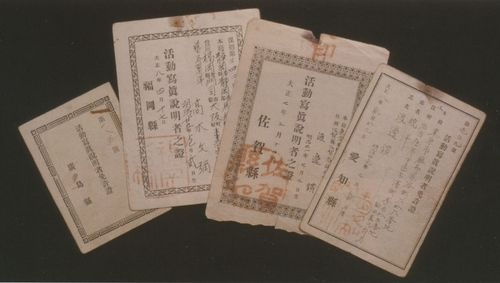This website was developed by Sarah Bither '13 and Melissa Yang '14, DHi 2011-2012 CLASS Scholars.
Training, Licensing, and Censorship
Training
By the end of the Meiji Era (1868-1912), a formal system for training new benshi began to emerge. In addition to the conventional master-apprentice arrangement, schools opened that trained benshi in their art of explanation called setsumei. The opening of formal schools was a rejection of the old iemoto system where performers, such as kabuki actors, were trained based on their familial ties. The schools allowed amateurs to enter, making the position of benshi all the more attractive, and thus created a new labor hierarchy based on popularity, not lineage. In 1913, in an effort to exert more control over the sudden influx of upstart benshi, the Nikkatsu Motion Picture Trust built the Motion Picture Benshi Training School (Katsudo Shashin Benshi Yoseijo). The benshi was now established as a legitimate profession.
Training schools offered voice lessons to strengthen a benshi’s voice. Foreign films especially required distinct vocal and presentation styles. Other courses were taught in such areas as history, geography, and English so that the benshi would give more knowledgeable film interpretations. Consequently, foreign film benshi were usually better educated since they had to be experts in all areas concerning the foreign cultures represented in the films they were narrating if they wanted to perform an accurate or even educational setsumei.
Licensing and Censorship
As the benshi profession evolved to increasingly reflect the role of a social educator, the government desired more control over the shape this ideal character should take. The government wanted people to interpret films morally. Even if the film was about evil, the setsumei had to be ethically sound. Benshi licensing (menkyo) and testing was soon implemented.
Benshi Licenses
Those aiming to enter the profession now had to submit a resume, have their background checked, and take a written exam testing their overall knowledge in order to obtain a license. Some questions pertained to academic subjects while others were more subjective. A benshi could be asked to explain “what effect motion picture setsumei has upon an audience, to “write down the articles of the Rules and Regulations Governing the Exhibition of Motion Pictures,” or to define “public safety and public morals” (Dym 125-126). Once this hard-won license was received, however, a license could easily be revoked. For example, by failing to carry the license on one’s person at all times. The difficult and fickle licensing process ensured, to a certain degree, higher quality benshi but also forced many out of the profession. This appeased many critics who thought that benshi tended to be low-class and dim-witted.
Censorship was also conducted on a personal, benshi to benshi basis. According to Aaron Gerow, a professor of Film Studies and East Asian Languages and Literatures at Yale University, the silent film industry depended on exhibition, not production. Censorship was thus enforced by patrolling theaters and performances and not by examining the films or scripts beforehand. The benshi, not the film, was held responsible for providing a moral means of entertainment (Fujiki).
Benshi legislation was separate from and stricter than that of other performance artists precisely because these orators were seen as more influential. They held sole control over their interpretation of a film. The licensing regulations quickly became a symbol of benshi popularity and the power they were beginning to hold over the film industry and Japanese society.


